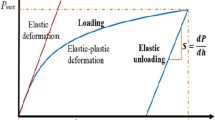Abstract
The finite element method has been used to study the behavior of aluminum alloy 8009 during elastic-plastic indentation to establish how the indentation process is influenced by applied or residual stress. The study was motivated by the experiments of the preceding paper which show that nanoindentation data analysis procedures underestimate indentation contact areas and therefore overestimate hardness and elastic modulus in stressed specimens. The NIKE2D finite element code was used to simulate indentation contact by a rigid, conical indenter in a cylindrical specimen to which biaxial stresses were applied as boundary conditions. Indentation load-displacement curves were generated and analyzed according to standard methods for determining hardness and elastic modulus. The simulations show that the properties measured in this way are inaccurate because pileup is not accounted for in the contact area determination. When the proper contact area is used, the hardness and elastic modulus are not significantly affected by the applied stress.
Similar content being viewed by others
References
T. Y. Tsui, W. C. Oliver, and G. M. Pharr, J. Mater. Res. 11, 752 (1996).
G. Simmons and H. Wang, Single Crystal Elastic Constants and Calculated Aggregate Properties: A Handbook, 2nd ed. (The M.I.T. Press, Cambridge, MA, 1971).
J. O. Hallquist, Lawrence Livermore National Laboratory Rept. UCID-19677, Rev. 1, University of California (1986).
W. C. Oliver and G. M. Pharr, J. Mater. Res. 7, 1564 (1992).
G. M. Pharr, W. C. Oliver, and F. R. Brotzen, J. Mater. Res. 7, 613 (1992).
I. N. Sneddon, Int. J. Engng. Sci. 3, 47 (1965).
F. J. Lockett, J. Mech. Phys. Solids 11, 345 (1963).
B. W. Mott, Microindentation Hardness Testing (Butterworths, London, 1957).
J. E. Ritter, T. J. Lardner, D. T. Madsen, and R. J. Giovinazzo, unpublished.
T. A. Laursen and J. C. Simo, J. Mater. Res. 7, 618 (1992).
T. A. Laursen, Duke University, private communication.
H. Gao, C-H. Chiu, and J. Lee, Int. J. Solids Structures 29, 2471 (1992).
A. Bolshakov, W. C. Oliver, and G. M. Pharr, in Thin Films: Stresses and Mechanical Properties V, edited by S. P. Baker, C. A. Ross, P. H. Townsend, C. A. Volkert, and P. Børgesen (Mater. Res. Soc. Symp. Proc. 356, Pittsburgh, PA, 1995), pp. 675–680.
A. Bolshakov and G. M. Pharr, unpublished.
G. Sines and R. Carlson, ASTM Bull. 180, 35 (1952).
A. L. Norbury and T. Samuel, J. Iron Steel Inst. 117, 673 (1928).
Author information
Authors and Affiliations
Rights and permissions
About this article
Cite this article
Bolshakov, A., Oliver, W.C. & Pharr, G.M. Influences of stress on the measurement of mechanical properties using nanoindentation: Part II. Finite element simulations. Journal of Materials Research 11, 760–768 (1996). https://doi.org/10.1557/JMR.1996.0092
Received:
Accepted:
Published:
Issue Date:
DOI: https://doi.org/10.1557/JMR.1996.0092




